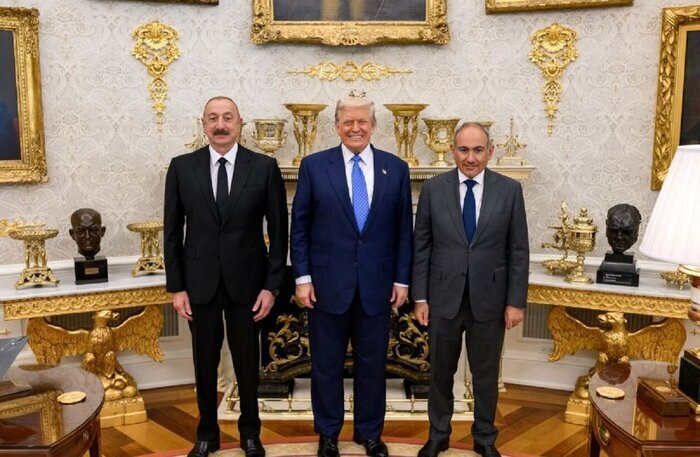Understanding the Armenia-Azerbaijan peace treaty: key points explained

TEHRAN – On Monday, the Armenian and Azerbaijani foreign ministries released the full text of a peace treaty the two countries agreed upon in March 2025.
The 17-article agreement lays out principles for normalizing relations after decades of hostility, including mutual recognition of borders, renouncing territorial claims, pledging non-aggression, and opening avenues for economic, transit, and cultural cooperation.
What is the Armenia–Azerbaijan peace treaty, and why is it significant?
The treaty is a comprehensive agreement aimed at establishing “a just, comprehensive and lasting peace in the region” between Armenia and Azerbaijan. It commits the two countries to establish “inter-state relations” based on respect for sovereignty, territorial integrity, and international law. As stated in the preamble, the Parties express their “mutual will to establish good-neighborliness,” reflecting the importance of ending decades of hostility and conflict.
How was the treaty reached?
The treaty text was agreed upon earlier in March 2025 and was initialed by both sides during a joint meeting in Washington, following the visit of Armenian Prime Minister Nikol Pashinyan and Azerbaijani President Ilham Aliyev. Initialing “formally confirmed both sides’ acceptance of the agreement’s wording and their commitment not to alter it,” although the treaty is not yet legally binding.
Is the treaty already in force?
No, the treaty is not yet in force. Article XVI states that the agreement “shall enter into force following the exchange of instruments notifying the completion of internal procedures in accordance with the national legislation of each Party.”
What are the treaty’s main commitments?
The treaty includes several key commitments, including:
– Recognition of each other’s “sovereignty, territorial integrity, inviolability of international borders and political independence” (Article I).
– Neither party “has any territorial claims against each other and shall not raise any such claims in the future” (Article II).
– Refraining from “the use of force or the threat of the use of force” against the other (Article III).
– Not allowing “any third party to use their respective territories for the use of force against the other Party inconsistent with the UN Charter” (Article III).
– Refraining from intervening in each other’s internal affairs (Article IV).
– Establishing diplomatic relations after ratification (Article V).
– Conducting “good faith negotiations” on border delimitation and demarcation (Article VI)
– Not deploying third-party forces along the border and implementing confidence-building measures (Article VII).
– Combating “intolerance, racial hatred and discrimination, separatism, violent extremism and terrorism” (Article VIII).
– Addressing cases of missing persons from the conflict (Article IX).
– Potential cooperation in economic, transit, environmental, humanitarian and cultural fields (Article X).
How does the agreement address the transit and transport routes?
While the treaty does not explicitly mention the specific transit routes, Article X allows for cooperation in “economic, transit and transport” fields, subject to future agreements: “In order to establish cooperation in various fields, including economic, transit and transport...the Parties may conclude agreements in respective areas of mutual interest.” This means transport corridors are to be negotiated further but must respect each country’s sovereignty as emphasized in Articles I and VI regarding borders.
What does the deal say about border delimitation?
Article VI commits the Parties to “conduct good faith negotiations between their respective border commissions...to conclude the Agreement on the delimitation and demarcation of the state border between them.” This negotiation must comply with Article I, which confirms recognition and respect for sovereignty and borders. Additionally, Article VII prohibits deployment of third-party forces along the mutual border and requires confidence-building measures for border security until demarcation is complete.
Will there be involvement of any third parties like the U.S.?
Article III states clearly: “They shall not allow any third party to use their respective territories for the use of force against the other Party in a way inconsistent with the UN Charter.” This prohibits third-party military involvement against either party from within each other’s territory.
How could the peace deal affect Iran’s position in the South Caucasus?
The treaty text does not mention Iran directly. However, by requiring respect for sovereignty and political independence (Article I) and promising cooperation on transit and transport under mutual agreement (Article X), the treaty implies that any transport corridors must respect the territorial integrity of all involved states, indirectly affecting regional dynamics including Iran’s connectivity.
What happens next?
According to Article XVI, the treaty will become legally binding only after both parties complete their internal ratification procedures and exchange notification instruments. Until then, the treaty is a formal but non-binding agreement. The final signing date remains uncertain, as Azerbaijan awaits Armenia’s constitutional amendments related to Nagorno-Karabakh.
Leave a Comment